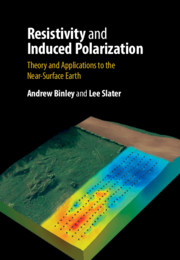Book contents
- Resistivity and Induced Polarization
- Reviews
- Resistivity and Induced Polarization
- Copyright page
- Contents
- Preface
- Acknowledgements
- Symbols
- 1 Introduction
- 2 Electrical Properties of the Near-Surface Earth
- 3 Instrumentation and Laboratory Measurements
- 4 Field-Scale Data Acquisition
- 5 Forward and Inverse Modelling
- 6 Case Studies
- 7 Future Developments
- Appendix A Modelling Tools
- References
- Index
- Plate Section (PDF Only)
7 - Future Developments
Published online by Cambridge University Press: 17 December 2020
- Resistivity and Induced Polarization
- Reviews
- Resistivity and Induced Polarization
- Copyright page
- Contents
- Preface
- Acknowledgements
- Symbols
- 1 Introduction
- 2 Electrical Properties of the Near-Surface Earth
- 3 Instrumentation and Laboratory Measurements
- 4 Field-Scale Data Acquisition
- 5 Forward and Inverse Modelling
- 6 Case Studies
- 7 Future Developments
- Appendix A Modelling Tools
- References
- Index
- Plate Section (PDF Only)
Summary
In this chapter, we offer some final remarks on areas of potential future development, targeting: petrophysics, instrumentation and modelling. We discuss how new modelling approaches, e.g. using pore-networks, are emerging to improve interpretation of electrical phenomena in porous media.We highlight some aspects of ambiguity in induced polarization (IP) properties and call for improvements in mechanistic petrophysical models of IP processes.New developments in instrumentation are discussed, highlighting the potential for time-lapse (monitoring) studies and the imaging of complex terrains using distributed measurement systems. Growth in the use of parallel computation for large-scale modelling problems is discussed.The emergence of machine learning methods is also highlighted.The need for improved methods for (and more adoption of) uncertainty estimation in inverse models is discussed.We close by recognizing the immense value and likely longevity of simple, more traditional, approaches for modelling resistivity and IP data.
Keywords
- Type
- Chapter
- Information
- Resistivity and Induced PolarizationTheory and Applications to the Near-Surface Earth, pp. 321 - 327Publisher: Cambridge University PressPrint publication year: 2020



